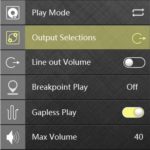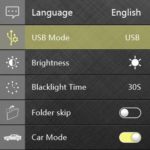General Information
Xduoo X20 ESS9018 DSD256 Portable Lossless Music Player with Balanced Output &Wireless Control
Description
Professional DAC chip, High reduction, high resolution, large sound stage
The professional DAC ESS9018 K2M chip is used to make the music signal highly reducible and high resolution. The sound stage is broader, enjoying the extraordinary experience brought by the well tuning, and feeling the true sound of the master tape quality music.
Dual oscillator , Accurate signal transmission ,Delicate tone
The independent double active ultra-low phase noise crystal oscillator is set as the clock source, and the jitter is reduced. Let music signal more accurate, do not appear signal distortions caused by timbre deviation.
Native DSD256, PCM384kHz/32bit,The full support of the mainstream music format
Native DSD256, IOS & DFF & DSF format, maximum support DSD256, let enjoying the beautiful music into the golden age, feel the original and most true recording. Support the mainstream audio format, no longer waste precious time for the music format transformation.
APE, FLAC, WAV, AIFF, ALAC, AAC, MP3, OGG, WMA
Design of reference level analog circuit
The benchmark level electronic components
Full balanced output, powerful to drive all kinds of earplugs
The 4-way LPF circuit, 6-way amp circuit, 4 balanced output, 2 single ended output, each drive current maximum output of 140MA greatly increase the output power, high quality music playback, broader soundstage, more accurate positioning, more details, more delicate sound, music is rich and colorful, natural and true.
Seek outstanding performance, regardless of the cost
With the widely praised super low distortion, ultra low noise OPA1612 benchmark operational amplifier chip, the atmosphere and details of the music are presented as real as the presence of the concert hall.
Effective reduction of distortion and back ground noise
In order to make the low noise and noise is not in the power supply circuit with high power conversion circuit, converted into power after the increase of LDO +/- low pressure to optimize the power regulator, to separate decoding chip, low-pass filter, amp power supply, further reducing the output distortion and noise so that the background music is more pure.
Bi-directional, Bluetooth transmission
Bluetooth digital turntable and Bluetooth DAC
Bluetooth 4.1 Bi-directional transmission, support the latest Apt-X Bluetooth protocol, can be used as a source of Bluetooth emission nondestructive digital signal connected with the Bluetooth headset, connect with car audio speakers and tuned to digital turntable, can also be used as a mobile phone’s Bluetooth broadcast DAC, meet lossless audio transmission quest, good sound follows you everywhere.
Hiby Link, save the annoyance of “taking out all the time”
There’s only one cell phone in your hand
Open the Hiby Link function, and X20 will be decoking Hiby through Bluetooth, you can control X20 through mobile phone to play songs, browse songs, adjust volume, search songs, file management and other functions, the realization of wireless connection without taking out the player to complete all operations, enjoy the convenience of wireless.
Bluetooth digital turntable
Car play mode, driving with more fun
The car play mode, by connecting with the car audio, enables X20 to follow the start of the car to start, play the music and follow the car to shut down automatically, so that your cat can also be HIFI, like a walking concert hall, enjoying the good music at any time.
Both lines and coaxial, support DOP and D2P
X20 also supports LO line output function and coaxial output function, taking into account the external amp amplifier only supports PCM decoding or signal but does not support DSD decoding, DOP and D2P two support in the design, the external expansion is compatible with no pressure.
Bi-directional USB & Type-C
Player but also DAC
The USB interface is no longer as a single use of data transmission or charging port, connected to the computer can be used as an external USB DAC decoding amp, let the computer turn into a large capacity HIGI player, even if the trip, travel can still enjoy the wonderful music.
USB: Connect with computer as a USB DAC, and the highest support for PCM 32bit/384kHz asynchronous decoding and DSD256 decoding.
Support USB OTG to read and play U disk music files;
Support USB AUDIO output functions, support DOP, D2P output, and connect with a decoder as a digital turntable.
10 sections of EQ and 18 kinds of sound effects, feel the charm of different sound effects
Choose your own sound effect based on your own preferences
In addition to the common set of regular sound effects, in addition to 10 custom EQ for your careful adjustment, ten sections of professional equalizer is used for bringing more melodious voice, so as to alleviate the lack of response on the earphone, make the music more balanced, signer’s voice is no longer covered by the background music.
Aeronautical aluminum CNC processing
From vision to touching, whole new griping experience
Using precision CNC processing, forming while body in one piece, using sand blasting technology on the surface, both texture and hand feel, The weight us moderate, the good grip and the good look shows a perfect, the good grip and the good look shows a perfect definition of the fashion and technology.
Specification
Headphone output: 3.5mm
Output power: 210mW (32Ω/THD +N<0.0015%)
Frequency response: 20Hz~20kHz (±0.15dB)
Signal-to-noise ratio (SNR): ≥114dB
Resolution: >75dB
Distortion + noise: 0.0015%@1kHz (32Ω@1kHz)
Balanced headphone output: 2.5mm
Line output: 300mW (32Ω/THD +N<0.0015%)
Frequency response: 20Hz~20kHz (±0.15dB)
Signal-to-noise ratio (SNR): ≥116dB
Resolution: >112dB
Distortion + noise: 0.0015%@1kHz (32Ω@1kHz)
Line out
Line output level: 1.7Vrms (10KΩ@1kHz)
Frequency response: 20Hz~20kHz(±0.15dB)
Signal-to-noise ratio (SNR): ≥114dB
Resolution: >108dB (10KΩ@1kHz)
Distortion + noise: 0.0012@1kHz (10KΩ)
Other parameters
Built-in 2400mAh rechargeable lithium polymer battery
Battery life: 8 hours (3.5mm headphone output)
About 7 hours (balanced headphone output)
Charging time: < 3 hours (DC5V 2A)
< 6 hours (DC5V 500MA)
Size: 110*56*16.6mm
Weight: 138g
Package
Xduoo X20
Description
Professional DAC chip, High reduction, high resolution, large sound stage
The professional DAC ESS9018 K2M chip is used to make the music signal highly reducible and high resolution. The sound stage is broader, enjoying the extraordinary experience brought by the well tuning, and feeling the true sound of the master tape quality music.
Dual oscillator , Accurate signal transmission ,Delicate tone
The independent double active ultra-low phase noise crystal oscillator is set as the clock source, and the jitter is reduced. Let music signal more accurate, do not appear signal distortions caused by timbre deviation.
Native DSD256, PCM384kHz/32bit,The full support of the mainstream music format
Native DSD256, IOS & DFF & DSF format, maximum support DSD256, let enjoying the beautiful music into the golden age, feel the original and most true recording. Support the mainstream audio format, no longer waste precious time for the music format transformation.
APE, FLAC, WAV, AIFF, ALAC, AAC, MP3, OGG, WMA
Design of reference level analog circuit
The benchmark level electronic components
Full balanced output, powerful to drive all kinds of earplugs
The 4-way LPF circuit, 6-way amp circuit, 4 balanced output, 2 single ended output, each drive current maximum output of 140MA greatly increase the output power, high quality music playback, broader soundstage, more accurate positioning, more details, more delicate sound, music is rich and colorful, natural and true.
Seek outstanding performance, regardless of the cost
With the widely praised super low distortion, ultra low noise OPA1612 benchmark operational amplifier chip, the atmosphere and details of the music are presented as real as the presence of the concert hall.
Effective reduction of distortion and back ground noise
In order to make the low noise and noise is not in the power supply circuit with high power conversion circuit, converted into power after the increase of LDO +/- low pressure to optimize the power regulator, to separate decoding chip, low-pass filter, amp power supply, further reducing the output distortion and noise so that the background music is more pure.
Bi-directional, Bluetooth transmission
Bluetooth digital turntable and Bluetooth DAC
Bluetooth 4.1 Bi-directional transmission, support the latest Apt-X Bluetooth protocol, can be used as a source of Bluetooth emission nondestructive digital signal connected with the Bluetooth headset, connect with car audio speakers and tuned to digital turntable, can also be used as a mobile phone’s Bluetooth broadcast DAC, meet lossless audio transmission quest, good sound follows you everywhere.
Hiby Link, save the annoyance of “taking out all the time”
There’s only one cell phone in your hand
Open the Hiby Link function, and X20 will be decoking Hiby through Bluetooth, you can control X20 through mobile phone to play songs, browse songs, adjust volume, search songs, file management and other functions, the realization of wireless connection without taking out the player to complete all operations, enjoy the convenience of wireless.
Bluetooth digital turntable
Car play mode, driving with more fun
The car play mode, by connecting with the car audio, enables X20 to follow the start of the car to start, play the music and follow the car to shut down automatically, so that your cat can also be HIFI, like a walking concert hall, enjoying the good music at any time.
Both lines and coaxial, support DOP and D2P
X20 also supports LO line output function and coaxial output function, taking into account the external amp amplifier only supports PCM decoding or signal but does not support DSD decoding, DOP and D2P two support in the design, the external expansion is compatible with no pressure.
Bi-directional USB & Type-C
Player but also DAC
The USB interface is no longer as a single use of data transmission or charging port, connected to the computer can be used as an external USB DAC decoding amp, let the computer turn into a large capacity HIGI player, even if the trip, travel can still enjoy the wonderful music.
USB: Connect with computer as a USB DAC, and the highest support for PCM 32bit/384kHz asynchronous decoding and DSD256 decoding.
Support USB OTG to read and play U disk music files;
Support USB AUDIO output functions, support DOP, D2P output, and connect with a decoder as a digital turntable.
10 sections of EQ and 18 kinds of sound effects, feel the charm of different sound effects
Choose your own sound effect based on your own preferences
In addition to the common set of regular sound effects, in addition to 10 custom EQ for your careful adjustment, ten sections of professional equalizer is used for bringing more melodious voice, so as to alleviate the lack of response on the earphone, make the music more balanced, signer’s voice is no longer covered by the background music.
Aeronautical aluminum CNC processing
From vision to touching, whole new griping experience
Using precision CNC processing, forming while body in one piece, using sand blasting technology on the surface, both texture and hand feel, The weight us moderate, the good grip and the good look shows a perfect, the good grip and the good look shows a perfect definition of the fashion and technology.
Specification
Headphone output: 3.5mm
Output power: 210mW (32Ω/THD +N<0.0015%)
Frequency response: 20Hz~20kHz (±0.15dB)
Signal-to-noise ratio (SNR): ≥114dB
Resolution: >75dB
Distortion + noise: 0.0015%@1kHz (32Ω@1kHz)
Balanced headphone output: 2.5mm
Line output: 300mW (32Ω/THD +N<0.0015%)
Frequency response: 20Hz~20kHz (±0.15dB)
Signal-to-noise ratio (SNR): ≥116dB
Resolution: >112dB
Distortion + noise: 0.0015%@1kHz (32Ω@1kHz)
Line out
Line output level: 1.7Vrms (10KΩ@1kHz)
Frequency response: 20Hz~20kHz(±0.15dB)
Signal-to-noise ratio (SNR): ≥114dB
Resolution: >108dB (10KΩ@1kHz)
Distortion + noise: 0.0012@1kHz (10KΩ)
Other parameters
Built-in 2400mAh rechargeable lithium polymer battery
Battery life: 8 hours (3.5mm headphone output)
About 7 hours (balanced headphone output)
Charging time: < 3 hours (DC5V 2A)
< 6 hours (DC5V 500MA)
Size: 110*56*16.6mm
Weight: 138g
Package
Xduoo X20






















































